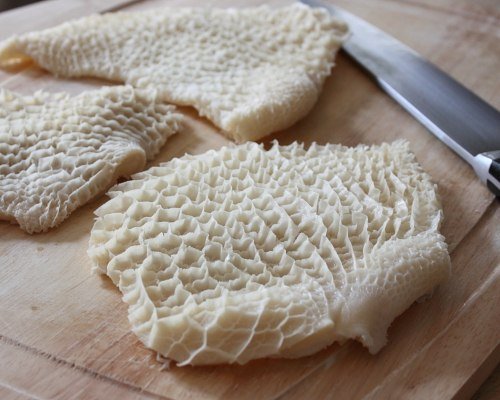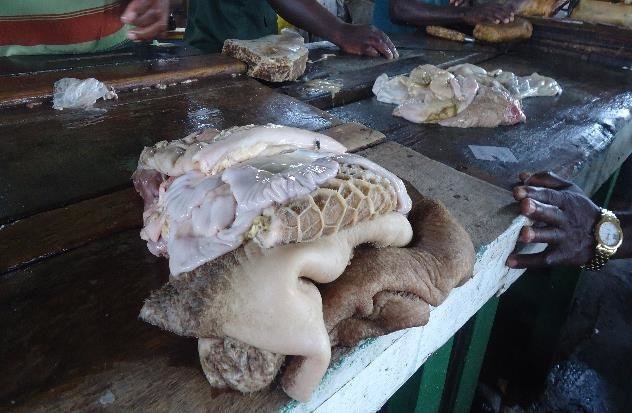-What Is Tripe
-Potential Benefits
For Nigerians, one of the most enjoyed parts of their delicacies is the part of the meat referred to as ‘inside meat’.
Inside meat refers to every part of the meat that can be found inside an animal’s stomach, especially cow.
There is this part of the ‘inside meat’ that we often refer to as ‘Towel’, if you’ve been calling it that, I want you to know that you’ve been calling the wrong name for so long.
The right Name for it is TRIPE.
Please, as from now on, let’s all call it ‘Tripe’ and not ‘Towel’.
What Is Tripe? A Nutritious Organ Meat Explained.
Organ meats are a concentrated source of nutrients that have been consumed since ancient times.
Recently, there has been a resurgence of interest in organ meats because of the popularity of premodern eating patterns like the Paleo diet.
READ ALSO: The Meat We Share In Our Umunna Meeting Does Not Respect Professor or Big Man, See Who It Respects!
Tripe is organ meat made from the edible stomach lining of farm animals.
This article tells you everything you need to know about tripe, including its nutrition, potential benefits and how to add it to your diet.

What Is Tripe?
Ruminant animals like cows, buffalo and sheep have multiple stomach chambers to properly digest their food (1Trusted Source).
Tripe refers to the edible muscle walls of the stomachs of these animals.
Considered an edible byproduct of animal slaughter, it’s sold for human consumption or added to animal foods, such as dry dog kibble.
Beef tripe is one of the most commonly eaten varieties.
Tripe is tough meat that needs to be prepared properly to become edible. It’s commonly cooked by moist heat methods, such as boiling or stewing.
It has a chewy texture and a mild taste, taking on the flavor of other ingredients it is cooked with.
Also, it can be stuffed with ingredients like blood, meat, herbs and spices to make slátur, a traditional Icelandic sausage similar to blood pudding.
There are four different beef tripe, classified depending on which stomach chamber the product was derived from.
Blanket or flat tripe: This type is made from the first stomach chamber of cows. This smooth tripe is considered the least desirable.
Honeycomb tripe: This variety stems from the second stomach chamber and resembles a honeycomb. It’s more tender than blanket tripe and has a more palatable flavor.
Omasum or book tripe: Coming from the third stomach chamber, this type of tripe is described as a mix between blanket and honeycomb tripe.
Abomasum or reed tripe: This variety is from the fourth stomach chamber. Its taste varies from strong to mild.
While tripe from different animals is consumed around the world, it’s not as popular as more common organ meats like heart, liver and kidney.
This slaughter byproduct is also a common ingredient in pet foods.
Packed With Important Nutrients
Organ meats are highly nutritious — and tripe is no exception.
READ ALSO: How You Prepare Tasty Egusi Soup
It’s low in calories but loaded with important nutrients your body needs to thrive.
A 5-ounce (140-gram) serving of cooked beef tripe provides (2Trusted Source):
Calories: 131
Fat: 5 grams
Protein: 17 grams
Vitamin B12: 15% of the Reference Daily Intake (RDI)
Selenium: 25% of the RDI
Calcium: 10% of the RDI
Zinc: 15% of the RDI
Phosphorus: 10% of the RDI
Iron: 5% of the RDI
Magnesium: 5% of the RDI
Tripe is also a good source of manganese and niacin (B3).
It is an excellent source of highly absorbable protein and contains an impressive amount of vitamin B12, selenium, and zinc — nutrients that are lacking in many people’s diets (3Trusted Source, 4Trusted Source, 5Trusted Source).

NOTE
Tripe is low in calories yet rich in protein, vitamin B12, and the minerals zinc and selenium.
Potential Benefits
Tripe can benefit both your health and your wallet in the following ways.
Rich in High-Quality Protein
Your body needs protein for vital processes, such as cellular communication, fluid balance, immune system function and tissue repair and maintenance (6Trusted Source).
Tripe is a complete source of protein, meaning that it contains all nine essential amino acids your body needs to function.
Adding protein-rich foods to your diet is an excellent way to lose excess body fat or maintain a healthy weight.
Protein is the most filling of all nutrients. Adding a protein source like tripe to meals and snacks can help reduce hunger, preventing the chances of overeating (7Trusted Source).
Affordable and Sustainable
Because tripe is not as desirable as steak and other meat products, it’s a more affordable protein option for those trying to save money.
Plus, purchasing tripe supports the nose-to-tail consumption of animals, which cuts down on food waste.
Unlike traditional methods in which every part of an animal killed for food was used, modern-day meat production often leads to less in-demand animal parts being thrown away (8Trusted Source).
Choosing to eat organ meats and other slaughter by-products like tripe promotes a less wasteful way of consuming animals.
Unbelievable: Meat Inside Rice Allegedly Turns Into A Snake (Video)
An Excellent Source of Vitamins and Minerals
Tripe packs an impressive amount of nutrients, including selenium, zinc and vitamin B12.
A 5-ounce (140-gram) serving of cooked beef tripe delivers 25% of the RDI for selenium and more than 15% of the RDI for both vitamin B12 and zinc.
Vitamin B12 is essential for red blood cell production, nerve transmission and energy production, while zinc is vital for cell division, immune function and carbohydrate metabolism (9Trusted Source, 10Trusted Source).
Selenium is a mineral that acts as a powerful antioxidant in your body. It’s also needed for DNA production, thyroid health and metabolism (11Trusted Source).
Additionally, tripe is a good source of the minerals calcium, phosphorus, magnesium and iron.

NOTE
Tripe is rich in protein and a number of vitamins and minerals. What’s more, it’s an affordable food that supports sustainable food practices.
Possible Downsides
Tripe is relatively high in cholesterol, with a 5-ounce (140-gram) serving packing in 220 mg of cholesterol — 75% of the RDI of 300 mg.
For most people, dietary cholesterol has little impact on overall cholesterol levels (12Trusted Source).
However, a small number of people are considered cholesterol hyper-responders and are more impacted by high-cholesterol foods.
For hyper-responders, it’s best to keep high-cholesterol foods like tripes to a minimum.
Aside from being rich in cholesterol, the smell, taste and texture of tripe might turn some people off.
Tripe is tough-textured meat that is usually pre-cooked before being sold to consumers.
However, it still needs to be cooked for a long period — usually two to three hours — before it’s ready.
In order to soften the texture, moist cooking methods like boiling or stewing are recommended.
Additionally, seasoning with spices and fresh herbs is recommended to enhance the bland flavor of tripe.
Even though cooking and seasoning should make this organ meat tastier, some people — especially those with aversions to chewy, textured foods — may not be a fan.
What’s more, some say that raw tripe has a distinct smell, which may not sit well with some people.
NOTE
The smell, taste and texture of tripe may turn some people off, especially if it’s not prepared in the right way. Plus, tripe is high in cholesterol, which may not be the best choice for those who are sensitive to high-cholesterol foods.
Follow Us On Facebook
Post Disclaimer
The opinions, beliefs and viewpoints expressed by the author and forum participants on this website do not necessarily reflect the opinions, beliefs and viewpoints of Anaedo Online or official policies of the Anaedo Online.

